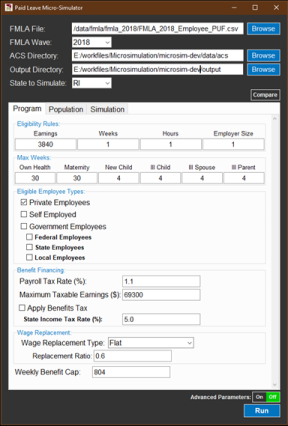Worker Paid Leave Usage Simulation Model
For the DOL’s Chief Evaluation Office, AIR and the Institute for Women’s Policy Research (IWPR) built a microsimulation model to simulate policies for paid worker leave in the U.S. The goal of this study was to create a publicly available paid leave microsimulation tool that is open-source and based on the familiar Albelda Clayton-Matthews/IWPR Paid Family and Medical Leave Simulation Model (ACM model).
The Challenge

The revised microsimulation model needed to have a user-friendly interface with easier manipulation of key policy parameters to simulate leave usage for a state or a local region.
The simulation tool also needed to employ new alternative methods to estimate leave behavior and to produce reports on leave usage and benefit costs based on the selected policy parameters.
Right: Paid Leave Micro-Simulator, Basic Parameters, under Program Tab
Our Role
Using the previous simulation model as a framework, the AIR team built from scratch the model simulation engines in both Python and R, two of the most popular open-source programming languages. The model code is fully transparent and publicly available to facilitate future data updates and model development.
Outcome
The result of our work was the Worker Paid Leave Usage Simulation (Worker PLUS), an open-source simulation tool that can be used by researchers and federal, state, and local policy makers to estimate the effects of various worker leave scenarios and policy options on worker leave-taking behavior, and to estimate the benefits paid as well as costs of administering any given program. The model has friendly graphical interface for increased accessibility by non-technical users while making the model code fully transparent and publicly available to facilitate future data updates, model development, and to engage with more sophisticated users.
As a companion to the simulation model, the team built a rigorously researched document that summarized the different types of administrative costs observed in planned and feasibility studies on state-level paid family and medical leave programs across US. The document guides the user on what are the important cost factor to consider when setting up a paid leave program, and gives an idea of how these costs assumptions varied across states. The users can also access an Excel template with various cost features to plan, estimate, and test the administrative costs of running a new program. The team also conducted research and shared a series of issue briefs to help researchers, policy analysts, and the public understand and use the Worker PLUS model. The issue briefs explore example simulations, model testing, and benchmarking studies.
Considerations for Equity and Algorithmic Bias
The WorkerPLUS enables research to shed light on paid leave access and usage among US workers, and to improve knowledge around a fair and equitable workplace. The model was designed to be open source to reach a large, diverse user base employing a user-friendly graphical interface that is intuitive for non-technical users. It allows easy access to policy parameters that can be manipulated by researchers with varying degree of programming skills. By making the model open-source, advanced users can customize the tool to fit their needs.
